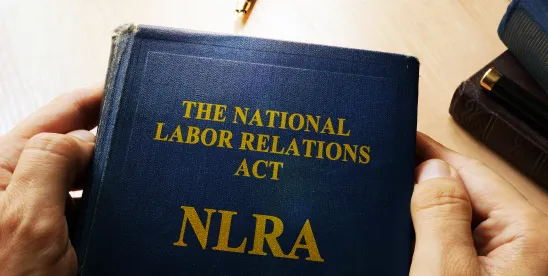The U.S. Supreme Court issued two blockbuster decisions this week, both of which likely will curtail the ability of federal agencies, including the NLRB, to prosecute cases and expand the law.
In a 6-3 decision announced Thursday in Securities and Exchange Commission v. Jarkesy et al., U.S., No. 22-859 (Jun. 27, 2024), the Supreme Court ruled that when the SEC seeks civil penalties against a defendant, the defendant is entitled to a trial by jury. As reported here, this decision could affect a future ruling in Space Exploration Technologies Corp., v. NLRB, No. 24-40315 (5th Cir. 2024), a case challenging the authority of National Labor Relations Board (“NLRB”) Administrative Law Judges (“ALJs”) on the same grounds.
Perhaps more significant, a 6-2 decision announced Friday in Loper Bright Enterprises et al. v. Raimondo, Secretary of Commerce, et al., No. 22-451 (Jun. 28, 2024), eliminates the deference given to federal agencies to interpret laws by reversing the Chevron decision.
Jarkesy: Viability of Agency Administrative Law Judges Put Into Question
Jarkesy Background
In 2013, the Securities and Exchange Commission (“SEC”) initiated an enforcement action and sought civil penalties for alleged fraud against Defendants. Relying on relatively new authority conferred by the 2010 Dodd-Frank Act, the SEC opted to adjudicate the matter itself before an agency ALJ. In 2014, the SEC ALJ issued a decision levying civil penalties as well as other relief against the Defendants.
Defendants petitioned for judicial review at the Fifth Circuit, which held in 2022 that the agency’s decision to have an ALJ adjudicate the case violated the Defendants’ Seventh Amendment right to a jury trial. The Fifth Circuit also identified two further constitutional problems: (1) Congress violated the nondelegation doctrine by authorizing the SEC to choose whether to litigate this action in court or adjudicate the matter itself; and (2) the insulation of SEC ALJs from executive supervision, with two layers of for-cause removal protections, violated the separation of powers doctrine.
On March 8, 2023, the SEC appealed the Fifth Circuit’s decision to the Supreme Court. Oral argument was heard on November 29, 2023.
Jarkesy Supreme Court Decision
The Supreme Court held that the Seventh Amendment of the United States Constitution entitled Defendants to a jury trial where the SEC sought civil penalties for securities fraud. Writing for the majority, Chief Justice John Roberts reasoned that the SEC’s antifraud provisions “replicate common law fraud” claims, which must be heard by a jury. As a result, where a claim brought by an agency (1) resembles common law causes of action; and (2) seeks a remedy traditionally obtained in a court of law, a Seventh Amendment jury right attaches to the claim.
The Court recognized an exception to this general rule under a “public rights” doctrine, which permits non-Article III courts to adjudicate matters that “historically could have been determined exclusively by [the executive and legislative] branches.” However, causes of action that are “quintessentially suits at common law” and not “closely intertwined” with a public right—like the anti-fraud provisions at issue here—are unable to utilize this exception and must be heard in Article III courts.
Because the jury trial issue resolved the case, the Court declined to reach the nondelegation or removal issues. As a result, the Fifth Circuit’s decision in Jarkesy on these issues remains good law.
Sotomayor Dissent in Jarkesy
In dissent, Justice Sonia Sotomayor argued that Congress has latitude—via the Constitution as well as prior Supreme Court decisions—to assign the enforcement of civil penalties “outside the regular courts of law.” This would be the case “even if the Seventh Amendment would have required a jury where the adjudication of those rights is assigned to a federal court of law instead of an administrative agency.”
Justice Sotomayor also raised issue with the majority’s interpretation of a public rights doctrine. Notably, the dissent challenges the majority’s claim that most causes of actions that should be protected under the doctrine involve areas of the law where political branches “traditionally held exclusive power…and had exercised it.” To this end, Justice Sotomayor argues that the majority cannot distinguish between Congress’ enacting of statutes such as the National Labor Relations Act (“NLRA”) and its enacting of the Dodd-Frank Act. The dissent implies that neither labor relations nor securities were traditionally governed by political branches, thus (purportedly) refuting the majority’s reliance upon this principle.
NLRB Implications
Similar to the SEC, the NLRB utilizes ALJs to adjudicate violations of the NLRA. Contrary to the SEC, however, the NLRB ALJ scheme has been in place for decades. These judges hear and decide unfair labor practice cases in quasi-judicial hearings that affect the rights of parties to the cases. Moreover, unlike potential violations of the NLRA, the SEC is not always the exclusive forum for vindication of securities issues. The Department of Justice often prosecutes securities laws issues and private plaintiffs can bring lawsuits to vindicate civil claims. Contrast this with the NLRB, which is the exclusive forum for the vast majority of issues arising under the NLRA.
In the wake of the Fifth Circuit’s 2022 decision in Jarkesy, on January 4, 2024, Space Exploration Technologies Corp. (“SpaceX”) filed a complaint in the Southern District of Texas challenging the constitutionality of NLRB ALJs. SpaceX specifically argued that: (1) the NLRB’s structure is unconstitutional in that it limits the removal of NLRB ALJs and Board Members and permits Board Members to exercise executive, legislative, and judicial power in the same administrative proceeding; and (2) the Board’s expanded remedies constitute consequential damages, and therefore violate employers’ Seventh Amendment right to a trial-by-jury.
Because the Supreme Court in Jarkesy declined to reach the nondelegation or removal issues, the Fifth Circuit’s decision on these issues remains good law. This makes the current forum battle even more significant, as the Jarkesy Fifth Circuit opinion could provide dispositive precedent for SpaceX’s removal and nondelegation arguments. In addition, the Supreme Court’s ruling on the Seventh Amendment issue might support SpaceX’s argument that the Board’s expanded consequential damages remedies should be adjudicated in a trial by jury, depending on how the court interprets the current state of NLRB remedies.
As reported here, in Thryv, Inc., 372 NLRB No. 22 (2022), the NLRB expanded remedies under the NLRA to include “all direct or foreseeable pecuniary harms suffered as a result of the respondent’s unfair labor practice.” The Board has been committed to expanding remedies since 2021, when General Counsel Jennifer Abruzzo issued a memorandum on this subject. NLRB Regional Offices have also been aggressive in seeking these expanded remedies, which arguably are punitive rather than remedial in nature. In its Complaint, SpaceX used the Board’s position on remedies, coupled with the Jarkesy Fifth Circuit ruling, to argue that the Board has sanctioned compensatory relief that can only be issued through a trial by jury.
However, this position could be impacted by the Fifth Circuit’s ruling in Thryv, Inc. v. NLRB, No. 23-60132 (5th Cir. May 24, 2024). In this decision, the Court vacated the Board’s ruling in Thryv, Inc., 372 NLRB No. 22 (2022) on the merits, and thus did not reach the consequential damages issue. The Court did however label this remedy as “draconian” and “a novel, consequential-damages-like labor law remedy.” The Board therefore will require a new case to codify the issuing of consequential damages. It remains to be seen how this ruling would impact SpaceX’s Seventh Amendment argument concerning consequential damages, which could be a key element of its potential reliance on the Supreme Court’s ruling in Jarkesy.
Court Deference to Agency Positions Dead: Chevron Reversal
In a massive blow to agency power, the U.S. Supreme Court on Friday reversed Chevron U.S.A. Inc. v. Natural Resources Defense Council, Inc., 467 U.S. 837 (1984), in a case involving a fishing industry rule. Under Chevron, on review of agency action, where the relevant statute was silent or ambiguous regarding a specific issue, courts were directed to defer to agencies and were not to “impose [their] own construction on the statute.” Thus, where an agency offered “a permissible construction of the statute,” courts were to defer to the agency even if the court would have reached a different conclusion. In the years since Chevron was issued, reviewing courts often remarked that they were bound to uphold an agency determination even if they disagreed with the interpretation. Justice Roberts, writing for the majority, held that Chevron could not be reconciled with the Administrative Procedures Act (“APA”), which commands “the reviewing court” to decide “all relevant questions of law” arising on review of agency action, which of course includes interpretation of the federal statute at issue. As a result, the majority determined that there should be no deference to agencies in answering legal questions, although deference is mandated for judicial review of agency policy-making and fact-finding. The majority concluded that, in deciding Chevron, the Supreme Court had required judges to “disregard their statutory duties,” which required this Court to “leave Chevron behind.”
Takeaways
These two Supreme Court decisions could substantially curtail the NLRB’s ability to bring and prosecute actions against parties (not just employers, but unions as well). While the Jarkesy Supreme Court decision is narrow, it could end the ability of the NLRB to bring certain claims in front of agency ALJs (all of whom are employed directly at the Board and who are not subject to removal). The pending SpaceX decision likely will further the development of the law, as it is a direct challenge to the NLRB adjudicatory scheme, and will also give a Circuit Court—and eventually maybe the Supreme Court—a chance to rule on additional constitutional challenges to federal agencies.
In addition, the reversal of Chevron likely will have a substantial effect on the review of NLRB cases. At time of unprecedented expansion of the reach of the NLRA—including finding non-compete agreements and confidentiality clauses unlawful—the end of Chevron deference allows a reviewing court the ability to disregard NLRB actions as not rooted in the NLRA or beyond the scope of the agency’s mandate. There is no doubt many challenges of NLRB actions will be brought as the probability of prevailing in a reviewing court has increased substantially with the end of deference.
As always, we will monitor decisions and agency actions to see how these important developments play out.




 />i
/>i
